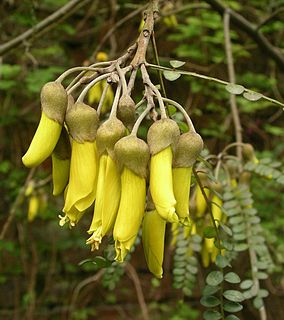
Kōwhai are small woody legume trees within the genus Sophora in the family Fabaceae that are native to New Zealand. There are eight species, with Sophora microphylla and S. tetraptera being the most recognised as large trees. Their natural habitat is beside streams and on the edges of forest, in lowland or mountain open areas. Kōwhai trees grow throughout the country and are a common feature in New Zealand gardens. Outside of New Zealand, kōwhai tend to be restricted to mild temperate maritime climates.

McMurdo Station is a United States Antarctic research station on the south tip of Ross Island, which is in the New Zealand-claimed Ross Dependency on the shore of McMurdo Sound in Antarctica. It is operated by the United States through the United States Antarctic Program (USAP), a branch of the National Science Foundation. The station is the largest community in Antarctica, capable of supporting up to 1,258 residents, and serves as one of three year-round United States Antarctic science facilities. All personnel and cargo going to or coming from Amundsen–Scott South Pole Station first pass through McMurdo. By road, McMurdo is 3 kilometres (1.9 mi) from New Zealand's smaller Scott Base.

Jonas Carlsson Dryander was a Swedish botanist.
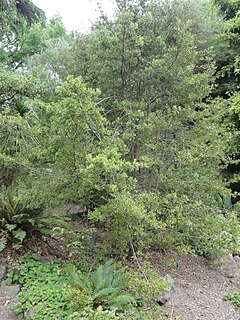
Phyllocladus, the celery pines, is a small genus of conifers, now usually treated in the family Podocarpaceae.Species occur mainly in New Zealand, Tasmania, and Malesia in the Southern Hemisphere, though P. hypophyllus ranges into the Philippines, a short way north of the equator.

Calotropis is a genus of flowering plants in the family Apocynaceae, first described as a genus in 1810. It is native to southern Asia and North Africa.

Phyllocladus trichomanoides, the tānekaha or celery pine, is a coniferous tree endemic to New Zealand.

Nothofagus fusca, commonly known as red beech is a species of southern beech, endemic to New Zealand, where it occurs on both the North Island and South Island. Generally it is found on lower hills and inland valley floors where soil is fertile and well drained. In New Zealand the species is called Fuscospora fusca.

Ipomoea indica is a species of flowering plant in the family Convolvulaceae, known by several common names, including blue morning glory, oceanblue morning glory, koali awa, and blue dawn flower. It bears heart-shaped or 3-lobed leaves and purple or blue funnel-shaped flowers 6–8 cm (2–3 in) in diameter, from spring to autumn. The flowers produced by the plant are hermaphroditic. This plant has gained the Royal Horticultural Society's Award of Garden Merit.
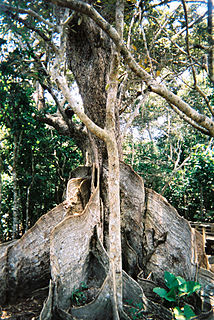
Heritiera littoralis, commonly known as the looking-glass mangrove or tulip mangrove, is a mangrove tree in the family Malvaceae native to coastal areas of eastern Africa, Asia, Melanesia and northern Australia. The common name refers to the silvery appearance of the underside of the leaves, resembling a mirror to some degree. The strong timber has uses in marine applications and elsewhere.

Lindsaeaceae is a pantropical family of ferns in the order Polypodiales. It contains six or seven genera with about 220 known species, some of which also extend into the more temperate regions of eastern Asia, New Zealand, and South America.

Oratia is a semi-rural locality on the western edge of metropolitan West Auckland in New Zealand.

Pseudocoremia fenerata is a moth of the family Geometridae. It is endemic to New Zealand.
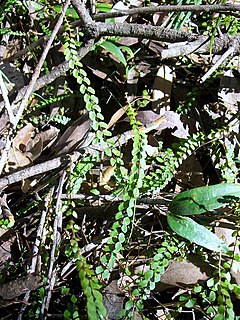
Lindsaea linearis is known as the screw fern, as the fronds may have a twisting appearance. A small fern of widespread distribution in many parts of Australia. Found in a variety of habitats, often near swamps or moist places. By rocks, heathland or open forest. It has a dark stem, unlike the similar necklace fern, which is green.

Lindsaea, common name necklace fern, is a genus of around 180 species of fern, 15 of which reach Australia. The name is in honour of surgeon John Lindsay of Jamaica. The genus is sometimes spelt Lindsaya.
Necklace fern is a common name for several plants and may refer to:
Adiantum cuneatum can refer to:

Dracophyllum ophioliticum, commonly known as asbestos inaka and asbestos turpentine tree, is a species of shrub in the family Ericaceae. Endemic to New Zealand, it grows into a sprawling shrub, reaching heights of just 30–200 cm (10–80 in), and has leaves which form bunches at the end of its branches.
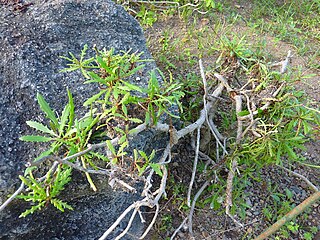
Tolpis succulenta is a species of flowering plant in the family Asteraceae native to the Portuguese archipelagos of the Azores and Madeira. It inhabits all islands.















